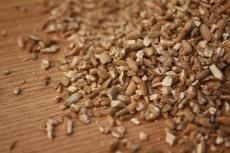Products

Chopped grain
Broken, Rolled and Sliced Rye and Wheat Grain
Since the very beginning of human evolution a man has been using various grain cultures – grain and various grain products – for food. Physiologically, the human body and the digestive tract are adapted to receiving nutritional substances from various vegetal sources, including grain cultures and their products. It has been found a long time ago that approx. 80% of nutrients and substances that are necessary for the human body is contained in the skin layers of grain – bran, and a particularly large quantity of nutritional substances can be found in the coat layers of grains.
On the market, there are a lot of products which is mainly made of bran and broken, rolled or sliced grain in one or another form. However, due to the peculiarities of the human digestive tract and very strong links of cellulose, lignin and other substances as well as the effect of chemical relations, the human digestive tract is practically incapable of absorbing, in a natural form, the majority of microelements, vitamins and other substances necessary for the body from bran, grain layers or coarsely broken grains. Bran and broken grain only clean the digestive tract as a “natural broom”; however, the substances necessary for the body are poorly absorbed. Finely milled, even if it is up to tenths of microns, grain increases, only by a tiny extent, the quantity of substances being absorbed.
Broken and rolled and sliced rye and wheat products are made using special equipment, after grain has been cleaned with grain cleaning machines. These products are preferred in bakeries where bread containing natural grain is baked. The soaking of grain takes a lot of time and requires additional containers in bakeries; therefore, rye and wheat grain started to be broken, rolled and finally sliced in order to get it soaked and swollen faster. Non-soaked grain cannot be used because dry grain would remain in baked bread. This occurs due to the fact that the time needed to prepare the bread dough is not sufficient for the soaking of grain, and non-soaked grain spoil the view of bread and it is problematic to chew it when eating bread. Broken grain gets swollen (soaked in water) much faster and it looks attractive in the crumb of bread, and there is no taste of hard dry grain when eating.
Purpose: Used as an additive in the production of different types of bread, particularly bread containing grain. Bread is enriched in microelements (Ca, Mg, P, Fe, K, Na) and vitamins (Group B, PP, C, E, provitamins A). Broken, rolled and sliced grain adds coarseness to bread.
Dosage: 10 – 50% flour quantity.
Use: boiling water can be poured on broken grain and it is left to soak for half an hour, or simply cold water can be poured on grain and it can be kept for approx. 4-5 hours in order to get soaked, and then grain is added to the dough. The further production process is carried out according to the technology chosen by the bakery.
Broken grain is produced by treating grain with the special rolling-mill. It is used to break the grain into uneven large pieces.
Rolled grain is produced using the special equipment – roll-type machine which presses – flattens grain.
Sliced grain – it is our most recent product – is produced using the special equipment which cuts the grain into 3 even parts and there is almost no flour during this process. Grain is approximately of the same size; it looks great and soaks faster and more evenly.
Packaging:
– 1 kg paper bag
– 10 kg paper bag
– 25 kg paper bag
Do you have any questions? Write to us!
More:
Follow the news:
This website uses cookies. By clicking ‘Agree’ or by continuing to browse, you give us your consent to use cookies. You can cancel your consent at any time, by adjusting your browser settings and deleting the cookies. You can find more detailed information in our privacy policy.
Accept